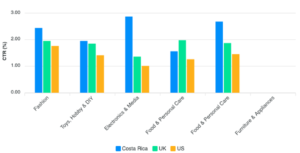Costa Rica’s use of technology has increased tremendously throughout the years. Embracing technology as necessary, earning it the title of the “scientific and technological powerhouse of Central America” (Staff, 2019). Technology is proving to be an important tool for advancement in the fashion retail sector in Central America. Several shifts in the fashion perspective across Central America are apparent as businesses transition from in-store operations to online platforms. The upcoming countries where H&M plans to launch its online website include Paraguay and Colombia, marking a significant expansion in their digital presence (Rigby, 2021). H&M online presence allows the company to reach a broader audience. Costa Rica stands out as one of the Latin American nations experiencing a surge in cross-border online purchases, constituting 53% of its overall e-commerce (Americas Market Intelligence, 2022). The distinctive online consumer behavior in Costa Rica, emphasizes the significant role of online transactions in shaping the country’s e-commerce landscape.
Costa Rica has witnessed a surge in e-commerce adoption, with projections of $3.2 billion in market growth over the next five years, primarily fueled by 44% of individuals aged 18 to 34 engaging in online shopping (Maddox, 2023). This trend is further evident in Costa Ricans’ increased susceptibility to online advertising compared to the U.S. (Figure 9), signifying a shift towards internet-driven consumer behavior. E-commerce’s popularity in Latin American countries, like Brazil and Mexico, has increased, with Brazil expected to generate $47.6 billion and Mexico $42 billion in online sales revenue (Chevalier, 2023). The pandemic accelerated this transformation, with platforms like “Mercado Libre” in Latin America doubling their daily sales in the second quarter of 2020 (Popov, 2021). This digital shift has extended to Central American countries, fostering increased revenue and reshaping business operations.
Figure 9.
Average CTR cost in Costa Rica.



